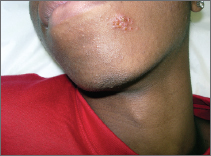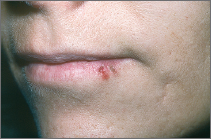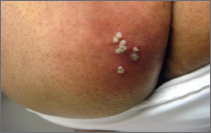The herpes simplex virus (HSV) causes small, fluid-filled blisters on a red base on almost any part of the body. The most common location is on the edge of the upper or lower lip; there the blister is often referred to as a “cold sore” or “fever blister.”
After the primary infection heals, the virus retreats to nerve cells, where it goes into a resting, or dormant, phase. HSV remains dormant until it's reactivated by precipitating factors or triggers, such as sun exposure, menstrual cycles, fever, common colds, and emotional stress.
Herpes simplex virus type 1
Most people contract HSV-1 in infancy or childhood, most of the time without their realizing it.
This highly contagious virus is spread by direct contact with the skin of family members or friends who already have the virus.
Herpes simplex virus type 1
HSV-2 causes genital herpes, although HSV-1 can also infect genital skin.
This disease is also highly contagious, especially when the blisters are active. It becomes noncontagious when the blisters are all crusted over.
Herpes simplex virus type 2
The primary infection may go unnoticed (subclinical infection), but when it does cause symptoms, it's often more severe than a recurrent infection. It may result in swollen glands and fever.
After a primary infection heals, HSV stays in the body and moves to nerve cells, where it remains in a resting state.
The blisters may never recur or may reappear in the same area.
Recurrent infections tend to be milder than primary infections.
They can be set off (reactivated) by a variety of situations in different people.
Some people may have recurrences that are infrequent, or they may have them once per month.
One or 2 days before blisters appear, there is often tingling, itching, numbness, or pain in the area. This is called the prodrome.
Over time, recurrences decrease in frequency, and they often stop altogether.
Recurrent (episodic) HSV. Treatment should begin during the prodrome, because this can often stop the blisters from erupting.
Oral antiviral medications such as Famvir and Valtrex are most effective. Take the medication in a dosage of _____ for _____ day(s).
You can carry the pills with you and take them at the first sign of symptoms. This is easy for women, but often men have nothing in which to carry the pills, so men should use a pill carrier or a key chain carrier.
Persistent or frequent recurrent HSV. For suppression, take the medication in a dosage of _____ daily.
Condoms may be helpful to prevent the transmission of HSV to sexual partners.
Many people are not aware that they have the infection and may be asymptomatic carriers.
A pregnant woman who has active HSV may pass on the infection to her infant at the time of delivery.
A recurrence that arises many years later may be mistaken for a primary episode, leading to unjust accusations about the origin of the herpes infection.
Also, women who have had genital HSV are more likely to have cervical cancer, and they should have yearly Pap smears.
Outline



